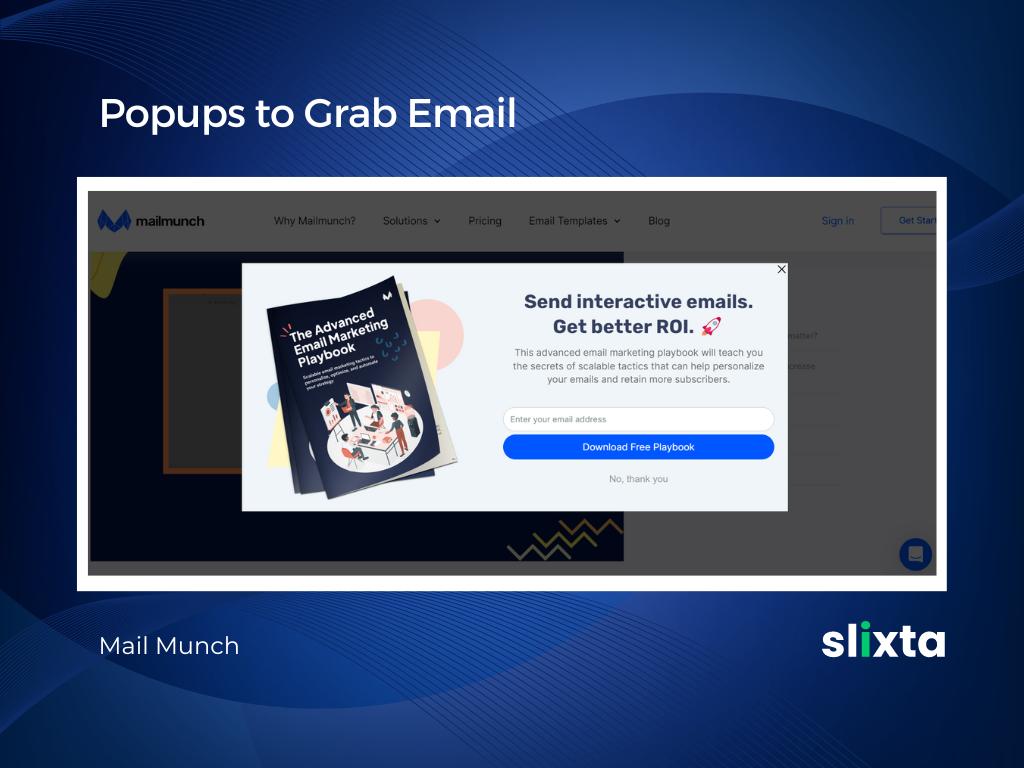Popup campaigns are effective in capturing email leads and growing lists when strategically implemented. Providing incentives, user-friendly designs, and precise targeting can boost engagement. Balancing effectiveness with a positive user experience is crucial.
Building a robust email subscriber list is essential for effective marketing strategies. Popups, those unassuming windows that grace websites, wield remarkable potential in this pursuit.
When tactically deployed, popups serve as potent catalysts, propelling your email list to new heights. By prioritizing user experience, delivering genuine value, and upholding transparency, popups have the transformative ability to convert passive website visitors into committed subscribers.
This not only expands your reach but also nurtures enduring connections with your audience, laying the foundation for enduring and meaningful relationships.
Lead Capture Popups
Lead capture popups are interactive website elements designed to capture the contact information of visitors, turning them into potential leads for a business.
These popups typically appear as small windows or overlays on a website's interface, prompting visitors to provide their details, such as names, email addresses, or phone numbers.

The primary purpose of lead capture popups is to gather information from interested visitors, allowing businesses to establish a direct line of communication and nurture these leads for potential conversions.

Why Popups are One of the Best Strategies to Capture Emails?
Popups are considered one of the best strategies for capturing email leads and growing your list for several compelling reasons:
Immediate Attention
Popups demand immediate attention from website visitors, as they overlay the content on the screen. This immediate focus can significantly increase the chances of visitors noticing the email subscription offer.
High Visibility
Popups are highly visible and can be strategically placed to ensure that they are noticed by all visitors. Whether appearing upon entry, exit intent, or after a specific duration, popups capture attention effectively.
Incentivized Offers
Popups allow you to present enticing offers or incentives, such as discounts, exclusive content, or freebies, in exchange for an email address. Visitors are more likely to subscribe when they perceive added value in doing so.
Lead Segmentation
Popups can be tailored based on the specific content or product category a visitor is engaging with. This targeted approach allows for personalized subscription offers, increasing the likelihood of conversion.
Exit-Intent Technology
Exit-intent popups detect when a visitor is about to leave the site and display a popup at that moment. This smart timing can capture abandoning visitors, giving you a chance to retain them as subscribers before they exit the site.
A/B Testing Capabilities
Popups offer the flexibility to conduct A/B tests easily. You can experiment with different designs, copy, offers, and timings to determine what resonates best with your audience, optimizing your strategy for maximum effectiveness.
Data Collection
Popups can collect additional data beyond just email addresses, such as names, preferences, or locations. This valuable information can be utilized for targeted marketing campaigns, enhancing overall engagement.
Mobile Responsiveness
With the majority of internet users accessing websites via mobile devices, mobile-responsive popups ensure a consistent and optimized user experience across various screen sizes, maximizing conversion rates.
Bets Practices While Using Email Capturing Popups on Your Websites
Employing lead-capturing popups to grab email addresses requires a delicate balance between engaging your visitors and respecting their user experience.
Provide Value
Offer a compelling incentive to encourage visitors to provide their email addresses. This could be a discount, a free e-book, exclusive access to content, or any other valuable offering related to your business.
Timing is Everything
Use exit-intent technology or time-delayed popups to display the form when visitors are about to leave or after they have spent some time on your site. Interrupting their experience immediately upon arrival might drive them away.
Clear and Concise Copy
Keep the popup message clear, concise, and benefit-oriented. Clearly explain what visitors will get by subscribing and how it will add value to their lives.
Simplicity is Key
Ask for minimal information. In most cases, asking for just an email address is sufficient. The more fields you include, the less likely visitors are to complete the form.
Mobile-Friendly Design
Ensure that your popups are mobile-responsive. A large percentage of internet users access websites from mobile devices, so your popups must provide a seamless experience on smartphones and tablets.
Transparency and Trust
Clearly state your privacy policy and inform users how their email addresses will be used. Transparency builds trust, increasing the likelihood of visitors subscribing willingly.
Integrate with Email Marketing Tools
Integrate your popups with your email marketing software. This ensures that new subscribers are automatically added to your mailing list, saving you time and reducing the risk of manual errors.
Regularly Review Performance
Monitor the performance of your popups. Track conversion rates, analyze user behavior, and adjust your strategy accordingly. Regular reviews help you stay adaptive and responsive to your audience's preferences.
Overcoming Challenges: Navigating the Roadblocks of Popup Campaigns
While the potential benefits of popup campaigns are evident, challenges abound. Addressing these roadblocks is crucial for ensuring the sustained effectiveness of your email lead generation efforts.
Ad Blockers: A Growing Hurdle
The rise of ad blockers poses a significant challenge to popup campaigns. As users increasingly adopt ad-blocking tools, the visibility of popups diminishes. To overcome this hurdle, businesses must explore creative alternatives, such as integrating popups within the content or employing non-intrusive notification bars that comply with ad-blocker regulations.
User Fatigue: Balancing Engagement and Restraint
Even the most well-crafted popup campaigns can lead to user fatigue if overused. Balancing engagement and restraint is crucial to prevent users from feeling bombarded. Implement frequency capping to control the number of times a popup is displayed to an individual user within a specific time frame, ensuring a delicate balance between visibility and user comfort.
The Future of Popup Campaigns: Evolving Strategies for Ongoing Success
Staying ahead of trends and adapting to shifting user behaviors is key to the ongoing success of popup campaigns in email lead generation.
Interactive Popups: From Interruption to Engagement
The future of popup campaigns lies in interactivity. Rather than being perceived as interruptions, popups will evolve into engaging experiences that captivate users. Incorporating interactive elements, such as quizzes, polls, or live chat options, transforms popups into valuable tools for two-way communication, fostering a deeper connection with the audience.
Integration with AI: Smart Personalization
Artificial Intelligence (AI) is poised to revolutionize popup campaigns by enabling smart personalization. AI algorithms can analyze user behavior in real-time, tailoring popup content based on individual preferences and engagement patterns. This level of personalization enhances the user experience, increasing the likelihood of email lead capture.
Conclusion
In conclusion, lead-capturing popups, when implemented thoughtfully and strategically, can be powerful tools for growing your email list and fostering valuable connections with your audience. By offering compelling incentives, ensuring optimal timing, and maintaining a user-friendly experience, you can encourage visitors to willingly provide their email addresses. Remember, the key lies in providing genuine value, respecting user preferences, and continually optimizing your approach based on visitor behavior and feedback. With these best practices in mind, you can transform casual website visitors into engaged subscribers, paving the way for meaningful interactions and long-term customer relationships.
For more valuable insights and information, check out these recommended blogs:

